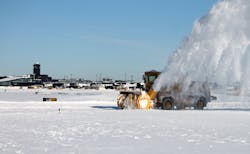When Winter Storm Jonas formed and took aim at the east coast of the U.S., airport leaders across the region braced for the worst.
The storm was expected to drop about 30 inches of snow across the Mid-Atlantic and up into New England for up to two days, which meant hundreds of flight cancellations and stranded passengers across the region.
However, at Baltimore/Washington Thurgood Marshall Airport (BWI), leaders were ready for the storm even before it ticked into weather models.
“Well, we begin our preparations for the snow season in general early in the year,” said Ricky Smith, chief executive officer of BWI. “We want our employees trained; our strategy on handling different types of snow has been determined; coordination with our airlines has already been discussed and established, including with the tower.
“Most of the work we had to do to prepare for this storm — for Jonas — or any other storm has happened months before.”
BWI implemented a strategy of keeping on top of snowfall and clearing the airfield in such a manner it reopened for service before others in the region, allowing time-sensitive flights to land in the region and get planes back in the air. Using communications and planning, airports can keep on top of snow removal no matter how big the storm gets.
Plans in Place
Carlton Braley, CM, assistant airport director, operations and facilities for Manchester-Boston Regional Airport said when preparing for a snowfall, airport officials hold conference calls with fleet and operations departments along with all the stakeholders in the facility, including the air traffic control tower, cargo shipping, FBOs, parking lot management and marketing department.
Braley said they start with the airlines to see what their plans are in terms of equipment needs, schedule changes and diversions, then get the same information from the FBOs and cargo facilities. Once the information is gathered it’s shared and coordinated with landside operations to make sure the plans conform.
Equipment and staff is prepared accordingly and he said the airport orders a season’s worth of sand and chemical to make sure it’s not hit by shortages.
“Now everyone, even the air traffic control tower knows what to expect and staffing can be adjusted and extra equipment can be put on different ramps,” he said.
Braley said Manchester-Boston looks to the forecast trend when preparing for storms as well. If a forecast goes from 3 inches to 6 inches of snow, then prepare for 8.
BWI had a plan in place, but all snowstorms are different, so Smith said airport leaders monitored forecasts from the National Weather Service (NWS) and local agencies so they would have the best information possible to handle the snow dump coming from Jonas. Once they knew it wasn’t going to be an ice storm and that it would consist of a prolonged heavy snowfall, Smith said BWI staff was prepared accordingly.
“We anticipated over 30 inches of snow and we got about 29 inches,” he said. “We knew we had to deploy the snow melters so we thought about deploying the right amount of snow melters. That was important because they had to be strategically located.”
Smith said BWI was fortunate to have all its airlines cancel all flights in anticipation of Jonas and remove their aircraft from the airfield because it allowed staff of 400 — 130 of which were airport employees — to move and mound snow tactfully.
“Knowing it was going to be a heavy dump, we had to try and not allow the snow to accumulate so high that we lost control of the ability to maintain snow removal elements on the airfield,” he said.
Keeping the Planes Cleared
Besides runway issues, airlines and FBOs need to clear their own equipment as snow falls onto the airport.
Tristan Smith, aviation vertical market manager for Big Ass Solutions, said fan systems can effectively defrost planes inside the hangar by bringing hot air from the top of the building and pulling it down to ground level.
“Hangars are some big open spaces and heat rises,” he said. “Fans can effectively, efficiently and cheaply get it down, even more so than the big blowers that might get it halfway to the floor then the air dissipates.
“Really, it’s almost impossible to heat a hangar. That’s a fact. To make matters worse, more hangars have high pressure sodium lights that’s heating the air and wasting all that energy.”
Smith said using fans to defrost the plane can be done efficiently by circulating air across the entire unit. It also dries the plane after defrosting and before maintenance, which in turn improves safety.
When using a fan for defrosting the plane, Smith said it’s important to make sure it’s on at all times in the winter, not just during working hours.
Make sure the fan is on the lowest speed possible as well, Smith said, to make sure it works the best. Some using fans will reverse the motors to heat the hangar, but Smith advised against that.
"Just put it on the lowest speed possible,” he said. “Some put it on reverse, but it’s a misconception that’s not necessary and it just messes up the motors."
Keeping Up with the Storm
Snow at BWI needed to be located near drainage systems set to capture contaminated melt so it can be recycled. Smith said they also knew the airfield would eventually reopen, there needed to be room to allow aircraft to access gates and the runway in an efficient manner.
Smith said employees worked on two 12-hour shifts for more than 24 hours, while making sure they were getting rest. They kept on top of the storm, but they met a challenge in the prolonged storm as fuel levels started to drop.
“Clearing snow to the fuel farm wasn’t a priority in the beginning, but it did become one when fuel levels became low,” Smith said. “The fuel farm was one area we lost control over until we started clearing it late Saturday when contractors began working on the fuel farm to get fuel to the snow melters.”
Coordinating with the tower allows equipment time to clear open runways at Manchester-Boston, Braley said. The tower will give operations a 10-minute window between flights so equipment staged at the runway approach can do a run on the full length of the runway and come back during the next 10-minute spot.
Meanwhile another team is clearing the ramp.
“We pretty much can touch 60 to 75 percent of the airfield every 30 minutes,” he said. “We’ve got a pretty good fleet of multitasking equipment.”
Braley said building communications amongst the snow team and other areas prepares the entities to work in tandem during snow events.
“We rely heavily on communication with the air traffic control tower,” Braley said. “We’ve built confidence. They’re very confident in our abilities and our communication and we’re very confident in their abilities, so everything we do is continuing to build on that confidence.
“We don’t want to freelance. We stick to the terminology. We don’t ask for something we know jeopardizes them in anyway. When our operators are on the field, even our movements are done in a deliberate way. When they know we’re approaching an area we’re not supposed to go, when we get near that runway or hold position we’re moving slowly or moving perpendicular so it doesn’t even look like we’re going to drive on that surface if they see us.”
“We have an enormous fleet to handle a snow storm of this size and we deployed every piece of all our 55 pieces of specialized equipment, including multifunctional equipment, snow blowers and front-end loaders,” Smith said. “We deployed everything in a strategic manner.”
One piece of equipment BWI didn’t have was something to remove snow from grassy areas. Instrument landing systems couldn’t be used if snow was above 18 inches on the grass, so Liberty Mountain Resort, a ski resort in Fairfield, Penn., loaned the airport a snowcat to clear the grassy areas. Smith said it was a major contributing factor in allowing BWI to reopen.
“BWI Marshall used that strategy back in 2010 as well and since there there’s a growing number of airports using this same strategy of creative and innovative approaches to addressing whatever challenges,” he said. “We don’t know all the challenges, but it’s this kind of innovation the team here brought in back in 2010 and are doing to handle Jonas and how we got through it."
Getting Back to Business
Smith said BWI went into the effort of making its airfield available as quickly as possible and made sure the roadways leading up to the airport were navigable, but the parking lots themselves didn’t get the same response.
“The primary focus was clearing the driveways to the shuttle buses so employees could move around, but we didn’t take into account early on the fact that at some point employees have to dig themselves out of the same snow,” he said. “The shuttle buses could get around but they didn’t address the issue of getting the employees out about six hours or so in when employees starting coming back so we actually had teams of workers deployed on our parking lots shoveling passengers out of their parking spaces.”
Smith said the airlines did a good job of getting word out on cancelled flights, so there weren’t a lot of issues with stranded passengers in the terminal. There was an issue with the Maryland Transit Administration’s (MTA) service to BWI, so shuttles were used to get employees from the facility to the right locations in the city to access bus and rail service.
“We didn’t want to push them over the edge,” he said. “We fed them well in a very good location to relax, or sit back and get some sleep and get away from everything.”
Smith said BWI wanted to keep the public well informed ahead of the storm on how prepared the airport was to handle the snow dump. Airlines communicated with the public to make sure they understood the status of flights. Communication continued between the airport and MTA and the highways department as well to keep information flowing on the status of transit and road connections to the airport.
“We were very honest with them, this is a huge storm and we’re doing everything we can to get the airport reopened and when it will be available to reopen,” Smith said. “We communicated that not just to the travelling public, but the airlines and the flying community.”
BWI's airfield opened about a day earlier than other airports in the region. Because of this, Smith said it was able to handle time-sensitive flights, such as the Boston Celtics coming in to play the Washington Wizards and the University of Maryland Terrapin’s flight back from a game in Michigan.
“We have employees here who really get excited when they get these kinds of challenges,” Smith said. “It’s kind of like when you’re an athlete who gets excited going into the big game because it’s what you live for. We have a lotof employees on the snow removal team that really believe this is what they’re here for.”
About the Author
Joe Petrie
Editor & Chief
Joe Petrie is the Editorial Director for the Endeavor Aviation Group.
Joe has spent the past 20 years writing about the most cutting-edge topics related to transportation and policy in a variety of sectors with an emphasis on transportation issues for the past 15 years.
Contact: Joe Petrie
Editor & Chief | Airport Business
+1-920-568-8399
>> To download the AviationPros media kits, visit: Marketing Resource Center
>>Check out our aviation magazines: Ground Support Worldwide | Airport Business | Aircraft Maintenance Technology

